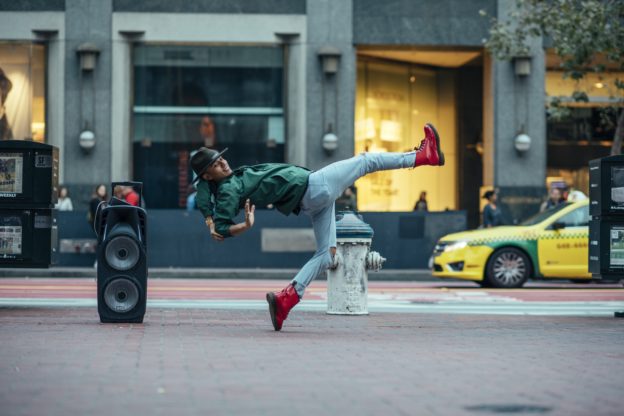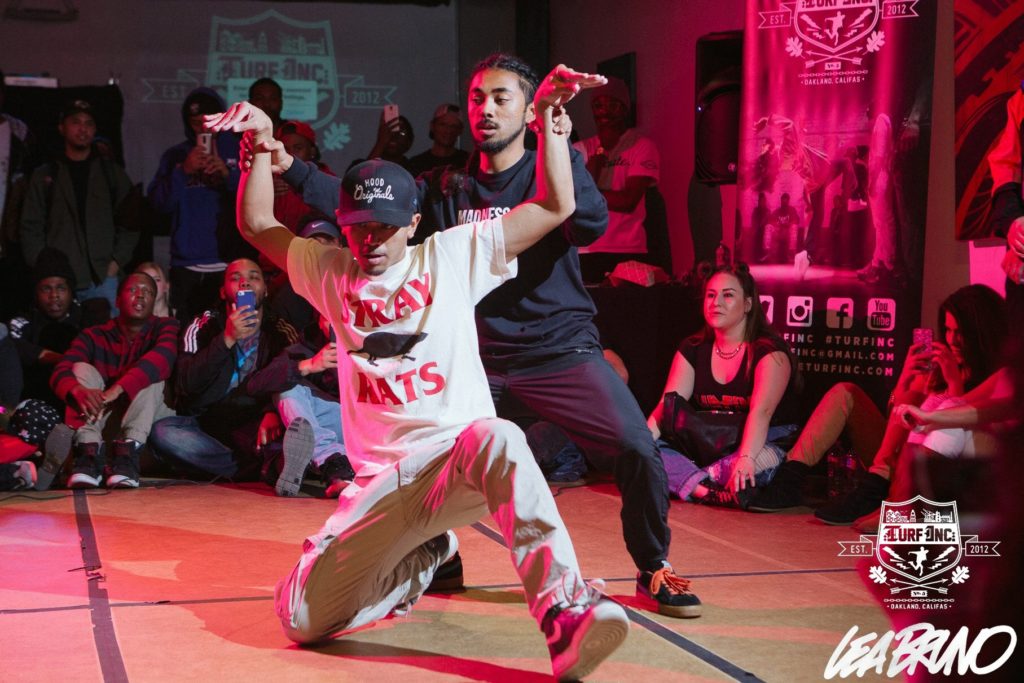
For many, Friday signals the end of a work week, but for Johnny Lopez, founder of TURFinc there are no days off. From managing day to day operations to talent scouting Johnny is involved in every aspect of his company. Founded in 2012, TURFinc’s mission is to spread the original dance culture of Turf that was established in Oakland, California and to utilize it as a positive platform for dancers, the youth, and the overall community. Turf dance infuses movement, storytelling and body contortions into a unique style of dance that often leave onlookers in amazement and bewilderment. The success of TURFinc has taken Johnny throughout the United States to share turf dance style with interested audiences. Though Johnny has received national and international recognition, he is committed to giving back to the East Oakland community that nurtured his talents. In his classes Turf dance is used as a tool to help gang members acknowledge and move through their trauma to positively impact their communities. While on a short break in between TURFinc 101 fundamentals class Johnny sat down for a conversation. Here are excerpts from conversation:
Aries Jordan: What is your background and how did you get into turf?
Johnny Lopez: I’m 28 years old, born and raised in Oakland. I’m a proud Mexican Americano. I speak fluent Spanish. My parents are from Mexico and Honduras. My first introduction to Turf dancing was back when I was about 10 years old at an Oakland sideshow. For those who don’t know, sideshows are midnight activity, with music and cars doing stunts. They are illegal now and used to happen more often back in the days. I used to go with a lot of my older cousins. One night! I saw a couple of guys just gliding on their feet. I was so mesmerized and was like “wow” I’ve never seen nothin like it. When I went back home I begin to try and emulate some of the movements. The older I got I went to more sideshows and found myself. I would listen to the music and watch the unique style of each dancer. I felt like it [turfin] was so me. I began getting better at gliding. At the age of 14 I learned of a dance crew and started going to their classes and sessions. The sessions weren’t always in a studio more like outside of people’s house or on sidewalks. During this time I discovered YouTube. That was huge! A young kid from Oakland I didn’t really know about technology or YouTube. I searched Turf dancing and all kind of dance battles came up. From there I felt like I needed to be there. So I went to a few battles and started learning more about dance styles outside of turfin. By the time I got to 21 I decided to start TURFinc not only to push the dance but the culture that made it. Ever since then I have been doing a lot of work to produce dance performances, even performing to an audience of 10,000 people. I teach workshops all over and have been casted for commercials, video and modeling shoots. I am now able to book my dancers every week. The way I remain grounded and pure with Turfin is because I keep it true to its original form. I did not give up on the culture and that is what makes me stand out from others now doing Turf dancing.
AJ: You talked about gliding, what are the elements of Turf that distinguish it from any other dance styles?
JL: The style of Turf dancing was started by youth in Oakland back in ‘95. The four elements that make up Turf dancing are footwork, storytellin, pantomiming, and Swagger. Gliding is an important part of footwork. Each movement tells a story. Pantomime is straightforward. But swagger is everything. Swagger is groove. Every dance style in the world has its own type of groove. For us in the Bay Area especially Oakland we had the hyphy movement. In the Hyphy movement you have a certain groove that make Oakland dancers standout. The hyphy movement preceded Turfin and is infused into the dance style. Back in the days Hyphy was its own genre of hip hop with its own style of dress, dance, and even language.
AJ: Turf dancers are known for body contortion; do you have to be super flexible or break a bone as it has been rumored, to Turf?
JL: The body contortion is another element of Turfin, that we added to the style. It’s just something you learn. For example, if you want to learn how to do a split, you will keep practicing. The same thing is true for bone-breakers, that’s only if you like a little bit of pain you’re going to go through.
 AJ: Now that Turf dancing has moved beyond the streets of Oakland to streets all over the world, what opportunities and challenges has this exposure presented to you and other street dancers?
AJ: Now that Turf dancing has moved beyond the streets of Oakland to streets all over the world, what opportunities and challenges has this exposure presented to you and other street dancers?
JL: I can’t take the full credit on how Turfin got out there. I used to be a part of a dance crew before I started TURFinc. The dance crew actually had the first video in the world to ever go viral for dancing on YouTube. This was back in 2005. When they went viral the dance itself went viral. All kinds of people started to wonder, what is Turf dancing? What is hyphy? Where is Oakland? The only bad thing that happened is the dance crew was not business-minded or prepared to take the craft beyond neighborhood turfs. Many of my crew members missed out on opportunities. When I started TURFinc I had my bio, promo videos and press kit material; so I had many of the things needed to seize opportunities. Even today this remains a challenge for Street Dancers, to adapt to the written and unwritten rules of business etiquette/protocol. Turfin is a dance style born out of the streets of Oakland, now it is in communities drastically different from what street dancers are used to, sometimes it is hard to adjust.
AJ: What can we expect from your upcoming performance with the Rotunda Dance Series in San Francisco City Hall?
JL: For this performance there will be a group of 9 famous dancers flying in from Paris. The movement they will be doing is what we call Open Style, which means they can do everything and merge into one style. They can do popping, breakdancing and contortion. From TURFinc dancers you will see pure Turfin and its evolution. Dancers will be popping, gliding, break dancing, and contortion all infused with elements of turf dancing.
AJ: What do you see as the future of Turf dancing?
JL: I want to see it remain pure and not lose the foundational elements I discussed earlier. I want to see it as another huge dance style that people are teaching and there’s still an interest in learning. For TURFinc we want to host dance battles and workshops around the world.
AJ: For someone that is interested learning Turf dancing?
JL: Go to Turfinc website theturfinc.com
This article appeared in the November 2018 edition of In Dance.

